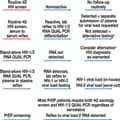Abstract and Introduction
Abstract
Objectives: Boston Medical Center (BMC) is a private, not-for-profit 514-bed academic medical center and legacy safety net hospital serving a diverse global patient population. BMC recently implemented a new HIV-1/HIV-2 Qualitative RNA PCR (HIV RNA QUAL) cleared by the US Food and Drug Administration to (1) replace antibody discrimination follow-up testing after a reactive fourth-generation (4G) serology screen and (2) use as a stand-alone diagnostic for suspected seronegative acute HIV infection.
Methods: This report summarizes the results of a production monitor for the first 3 months postimplementation.
Results: The monitor characterized test utilization, diagnostic turnaround time, impact on send-out testing, results reflexed to HIV RNA discrimination follow-up, and discrepancies between screening and HIV RNA results that necessitated additional investigation. Another element was the novelty of using HIV RNA QUAL while awaiting the existing Centers for Disease Control and Prevention HIV testing algorithm update. The 4G screening components and the HIV RNA QUAL were also used to create an algorithm specific to and compliant with current guidelines for screening patients on HIV preexposure prophylaxis.
Conclusions: Based on our findings, this new test algorithm may be reproducible and instructive at other institutions.
Introduction
The current Centers for Disease Control and Prevention (CDC) HIV diagnostic test algorithm endorses an initial highly sensitive screening test (preferred fourth-generation [4G] antigen-antibody serology) followed by a highly specific follow-up test (antibody discrimination assay), reserving molecular testing for analysis of discrepant results between screening and follow-up antibody discrimination.[1,2]
Reflex test options for detecting HIV-1 infection are included in current CDC HIV diagnostic algorithms. However, because HIV-2 remains uncommon in the United States, follow-up molecular tests in the current CDC algorithm are opt-in choices.[1] Until recently, a molecular diagnostic test for HIV-2 could require a commercial reference laboratory-developed test, as there was no commercial assay option cleared by the US Food and Drug Administration (FDA) available to routine diagnostic laboratories.[3,4]
Boston Medical Center (BMC) is a private, not-for-profit 514-bed academic medical center and legacy safety net hospital serving a diverse global patient population. BMC performs approximately 31,300 HIV screening tests annually using a 4G screening test (HIV 4G screen), which is a combination serology assay for detection of HIV-1 and HIV-2 antibodies and HIV-1 p24 antigen (ARCHITECT; Abbott Laboratories). Of note, the HIV 4G screen does not specify which targets are detected when a specimen tests positive. The lack of in-house HIV-1/2 RNA diagnostic testing has been a longstanding frustration due to delayed turnaround times for confirmation of discrepant serology results (ie, HIV 4G screen positive and antibody discrimination assay negative or indeterminate) and for suspected cases of seronegative acute HIV infection. This lack of in-house RNA testing sometimes prompted inappropriate orders for HIV-1 viral load testing, which is not validated for diagnostic purposes.
Before the change in the algorithm described herein, an estimated 0.7% to 1.2% of serology screens were both reactive and confirmed for HIV infection using a follow-up antibody discrimination assay (Geenius HIV 1/2 Test Device; BioRad) per current CDC algorithm.[1] As many as 18% of reactive screens were indeterminate or negative for HIV antibody and reflexed to a diagnostic HIV-1 RNA molecular test performed by an outside reference laboratory. The opportunity to use a new FDA-cleared molecular HIV-1/2 RNA assay in-house was especially attractive to this institution because the necessary instrument platform was already in place.
In order to incorporate an HIV diagnostic test for acute HIV infection, and for patients using preexposure prophylaxis (PrEP), the BMC clinical laboratory implemented the new FDA-cleared Cobas HIV-1/HIV-2 Qualitative RNA polymerase chain reaction (PCR) (HIV RNA QUAL; Roche Diagnostics) to replace the follow-up HIV-1/2 antibody discrimination after a reactive HIV 4G screen, using a serum-to-serum reflex workflow. Plasma specimens were requested on all patients with positive serum QUAL test results for follow-up viral load testing. The HIV RNA QUAL was also implemented with a stand-alone orderable test option for plasma specimens (HIV qualitative PCR Plasma, plasma QUAL) in cases of suspected seronegative acute HIV infection. Plasma specimens with detectable HIV RNA were then reflexed to HIV RNA quantitative PCR (plasma to plasma workflow), either an HIV-1 viral load test performed at BMC (QUANT) or an HIV-2 viral load test performed at a reference laboratory Figure 1. In addition to the above workflow, a stand-alone HIV RNA QUAL test order (laboratory orderable only) for serum was created to facilitate quality assurance and clinical evaluations requiring off-protocol investigation. BMC-licensed providers were informed about the new algorithm via a memo from the chief medical officer. As part of a 3-month postimplementation monitor for the new algorithm, we characterized (1) overall test utilization, (2) diagnostic turnaround time, (3) impact on send-out testing, (4) seropositivity and RNA positivity rates, and (5) analysis of discrepant serology-RNA results that warranted additional testing.
Figure 1.
Boston Medical Center HIV diagnostic configuration using HIV-1/2 QUAL PCR assay. Tests in red represent tests using serum. Tests in purple represent tests using plasma. aAlternative testing included HIV proviral DNA PCR (send out). PCR, polymerase chain reaction; PrEP, pre-exposure prophylaxis; 4G, fourth generation.
An additional element to this effort was the novelty of using HIV RNA QUAL prior to the update of the existing CDC HIV testing algorithm. Also, what emerged during implementation was the need for testing patients on HIV PrEP. Accordingly, the 4G screen test components and the HIV RNA QUAL were used to create an algorithm specific to and compliant with current guidelines for screening patients on PrEP. Based on our findings, this new HIV test algorithm may be reproducible and instructive at other institutions.
Am J Clin Pathol. 2023;160(1):11-17. © 2023 American Society for Clinical Pathology












